
A Bunsen burner, named after Robert Bunsen, is a kind of gas burner used as laboratory equipment; it produces a single open gas flame, and is used for heating, sterilization, and combustion.

A test tube, also known as a culture tube or sample tube, is a common piece of laboratory glassware consisting of a finger-like length of glass or clear plastic tubing, open at the top and closed at the bottom.
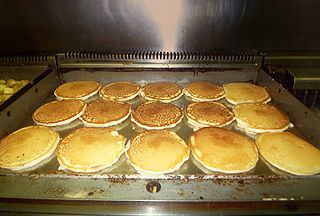
A griddle is a cooking device consisting of a broad flat surface heated by gas, electricity, wood, or coal, with both residential and commercial applications. In industrialized countries, a griddle is most commonly a flat metal plate, elsewhere typically a brick slab or tablet.

An agar plate is a Petri dish that contains agar as a solid growth medium plus nutrients, used to culture microorganisms. Sometimes selective compounds are added to influence growth, such as antibiotics.

A hot plate is a portable self-contained tabletop small appliance cooktop that features one or more electric heating elements or gas burners. A hot plate can be used as a stand-alone appliance, but is often used as a substitute for one of the burners from an oven range or a kitchen stove. Hot plates are often used for food preparation, generally in locations where a full kitchen stove would not be convenient or practical. A hot plate can have a flat surface or round surface. Hot plates can be used for traveling or in areas without electricity.
A pipeclay triangle is a piece of laboratory apparatus that is used to support a crucible being heated by a Bunsen burner or other heat source. It is made of wires strung in an equilateral triangle on which are strung hollow ceramic, normally fire clay, tubes. The triangle is usually supported on a tripod or iron ring. Unlike wire gauze, which primarily supports glassware such as beakers, flasks, or evaporating dishes and provides indirect heat transfer to the glassware, the pipeclay triangle normally supports a crucible and allows the flame to heat the crucible directly. The triangular shape allows rounded crucibles of various sizes to rest in a stable way.

A cooktop, also known as hob, is a device commonly used for cookery that is commonly found in kitchens and used to apply heat to the base of pans or pots. Cooktops are often found integrated with an oven into a kitchen stove but may also be standalone devices. Cooktops are commonly powered by gas or electricity, though oil or other fuels are sometimes used.
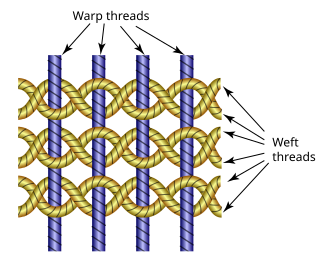
Gauze is a thin, translucent fabric with a loose open weave. In technical terms "gauze" is a weave structure in which the weft yarns are arranged in pairs and are crossed before and after each warp yarn keeping the weft firmly in place. This weave structure is used to add stability to fabric, which is important when using fine yarns loosely spaced. However, this weave structure can be used with any weight of yarn, and can be seen in some rustic textiles made from coarse hand-spun plant fiber yarns.

A gas burner is a device that produces a controlled flame by mixing a fuel gas such as acetylene, natural gas, or propane with an oxidizer such as the ambient air or supplied oxygen, and allowing for ignition and combustion.
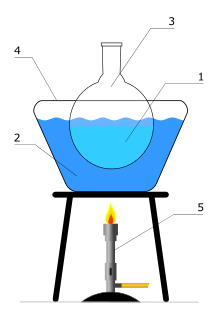
A heated bath is used in the laboratory to allow a chemical reaction to occur at an elevated temperature.

A heating mantle, or isomantle, is a piece of laboratory equipment used to apply heat to containers, as an alternative to other forms of heated bath. In contrast to other heating devices, such as hotplates or Bunsen burners, glassware containers may be placed in direct contact with the heating mantle without substantially increasing the risk of the glassware shattering, because the heating element of a heating mantle is insulated from the container so as to prevent excessive temperature gradients. Heating mantles may have various forms. In a common arrangement, electric wires are embedded within a strip of fabric that can be wrapped around a flask. The current supplied to the device, and hence the temperature achieved, is regulated by a rheostat. This type of heating mantle is quite useful for maintaining an intended temperature within a separatory funnel, for example, after the contents of a reaction have been removed from a primary heat source.
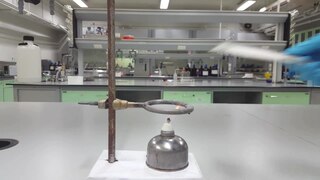
A wire gauze is a sheet of thin metal that has net-like patterns or a wire mesh. Wire gauze is placed on the support ring that is attached to the retort stand between the Bunsen burner and the glassware to support the beakers, flasks, or other glassware during heating. Wire gauze is an important piece of supporting equipment in a laboratory as glassware cannot be heated directly with the flame of a Bunsen burner, and requires the use of a wire gauze to diffuse the heat, helping to protect the glassware. Glassware has to be flat-bottomed to stay on the wire gauze.
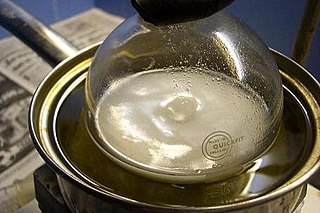
An oil bath is a type of heated bath used in a laboratory, most commonly used to heat up chemical reactions. It's essentially a container of oil that is heated by a hot plate or a Bunsen burner.
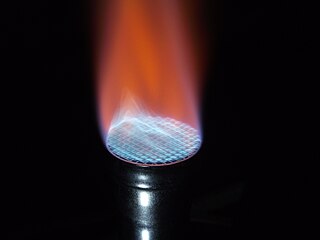
A Meker–Fisher burner, or Meker burner, is a laboratory burner that produces multiple open gas flames, used for heating, sterilization, and combustion. It is used when laboratory work requires a hotter flame than attainable using a Bunsen burner, or used when a larger-diameter flame is desired, such as with an inoculation loop or in some glassblowing operations. The burner was introduced by French chemist Georges Méker in an article published in 1905.
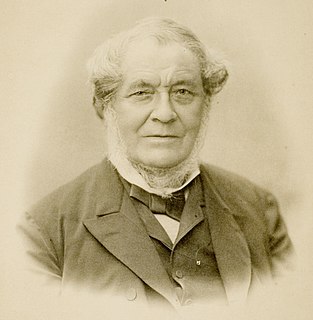
Robert Wilhelm Eberhard Bunsen was a German chemist. He investigated emission spectra of heated elements, and discovered caesium and rubidium with the physicist Gustav Kirchhoff. The Bunsen–Kirchhoff Award for spectroscopy is named after Bunsen and Kirchhoff.

An iron ring or ring clamp is an item of laboratory equipment which comprises a conjoined metal ring and radially-extending rod. In some cases, the rod terminates in a screw clamp for attachment to a retort stand or other support; in others, the rod may be attached to a stand by means of a laboratory clamp holder. Iron rings are commonly used in chemistry laboratories for supporting apparatus above the work surface, for example:
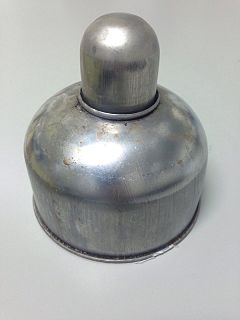
An alcohol burner or spirit lamp is a piece of laboratory equipment used to produce an open flame. It can be made from brass, glass, stainless steel or aluminium.

Crucible tongs are scissor-like tools, but instead of having two blades, these tools are replaced with two pincers or pieces of metals that concave together, which allow the users to grasp a hot crucible, flasks, evaporating dishes, or even small beakers. They are made of durable metals, allowing them to endure a very hot temperature when touching with the hot objects.

An inoculation needle is a laboratory equipment used in the field of microbiology to transfer and inoculate living microorganisms. It is one of the most commonly implicated biological laboratory tools and can be disposable or re-usable. A standard reusable inoculation needle is made from nichrome or platinum wire affixed to a metallic handle. A disposable inoculation needle is often made from plastic resin. The base of the needle is dulled, resulting in a blunted end.
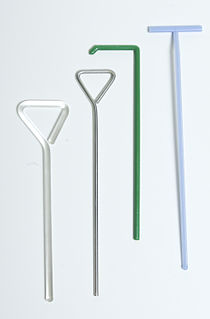
A cell spreader or plate spreader is a hand tool used in biology and related fields to smoothly spread cells and bacteria on a culture plate, such as a Petri dish.



















